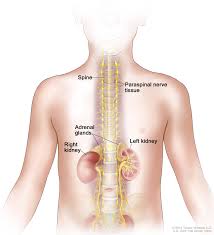Neuroblastoma Causes, Symptoms, Diagnosis and Treatment

What Is Neuroblastoma?
Neuroblastoma is a cancer which is known to develop from immature nerve cells found in different areas of the body.
It generally originates in either of the adrenal glands, but it can also develop in nerve tissues in the neck, chest, abdomen or pelvis.
Stages Of Neuroblastoma:
Neuroblastoma can be divided into the following stages:
- Stage I
- Localized
- Lymph node connected to the tumor may have cancer
- Stage IIA
- Localized
- Not easily removable
- Stage IIB
- Localized
- Not easily removable
- Lymph nodes, those connected as well as those nearby, contain cancer cells
- Stage III
- Advanced neuroblastoma
- Impossible to remove via surgery
- Lymph nodes may or may not contain cancer cells
- Stage IV
- Advanced neuroblastoma
- Metastasized to other parts of the body
- Stage IVS
- Behaves differently to other forms of neuroblastoma
- Applies only to children under the age of one
- Spreads to another part of the body (skin, liver etc)
- Does not require treatment generally
Causes Of Neuroblastoma:
Neuroblastoma, like other cancers, is caused by genetic mutation. The cause of the genetic mutation is unknown.
Neuroblastoma begins in immature nerve cells (Neuroblasts) that a fetus makes as part of its development process.
Upon reaching maturation, the neuroblasts turn into nerve cells. Upon birth these neuroblasts disappear. However, if they don’t they form a tumor-a neuroblastoma.
Symptoms Of Neuroblastoma:
Neuroblastoma usually begins with the occurrence of the following symptoms:
- Fatigue
- Loss of appetite
- Fever
- Joint pain
- Dark circles
- Proptosis
Later on, the symptoms exhibited depend on primary tumor locations and metastases if present:
- In the abdomen, a tumor may cause
- swollen belly
- A tumor in the chest may cause
- Breathing problems.
- Chest pains
- Drooping eyelids
- Unequal pupil size
- A tumor pressing on the spinal cord may cause weakness and thus an inability to stand, crawl, or walk.
- Bone lesions in the legs and hips may cause pain and limping.
- A tumor in the bones around the eyes or orbits may cause distinct bruising and swelling.
- Infiltration of the bone marrow may cause pallor from anemia.
Diagnosis Of Neuroblastoma:
Neuroblastoma can be diagnosed via the following tests and procedures.
- Physical exam
- Urine and blood tests
- Imaging test
- CT scan
- X-ray
- Ultra sound
- MRI
- metaiodobenzylguanidine (MIBG)
- Removing a sample of tissue for testing.
- Removing a sample of bone marrow for testing
After confirming diagnoses, the doctor may order further tests to diagnose the stage of neuroblastoma.
Treatment Of Neuroblastoma:
Treatment of neuroblastoma can be divided into the following categories:
- Surgery
- Chemotherapy
- Radiation therapy
- Stem cell transplant
- Immunotherapy
By : Natural Health News




